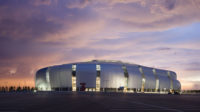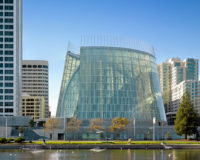The Chelsea neighborhood in Manhattan is still Art Gallery Central, its origins dating at least to the 1990s, when low-rise warehouses and reasonable rents began luring these venues from SoHo. As with SoHo’s fate—by which escalating real-estate prices brought high-end retail shops and condos and shooed away galleries and artists’ lofts—the overwhelming popularity of the High Line along the west edge of Chelsea and the rapid construction of luxury residential towers could again demonstrate that economic gains come with cultural losses. But, for now, the mix is lively, even if many galleries are counting on the largesse of landlords.
Additional Content:
Jump to credits & specifications
The art dealer Paul Kasmin, who got his foothold in SoHo before coming to Chelsea, has just opened his fourth establishment in the neighborhood. These have all been designed by studioMDA, headed by Markus Dochantschi, whose reputation as a gallerists’ architect has increased significantly since he started his New York practice in 2002. Dochantschi started by creating display booths at large art fairs, which then led to permanent galleries for some of the same clients. Kasmin was one: as he says, Dochantschi’s approach is “expressly crafted to show art at its best.”
In making incursions into Chelsea, Kasmin found two properties on 27th Street, west of the High Line, and two more in a block just to the east. He decided to renovate three of the four buildings (of which one needed only a new facade). As for the fourth, at 509 West 27th Street, Kasmin and studioMDA decided to replace the existing structure with a ground-up showcase for art. Each in the studioMDA foursome differentiates itself from the general Chelsea cohort by virtue of having a white facade and linear black metal sash for doors and windows, and each is geared to different types and sizes of art: this latest gallery, a poured-in-place concrete structure, easily accommodates large paintings inside its expansive, column-free interior.
The new building’s entrance facade even sets it apart from Kasmin’s cluster: it looks like a gigantic picture frame. A textured concrete proscenium surrounds a black-metal and glass storefront that extends upward 15 feet. Dochantschi gave this abstract frame an architectonic quality by angling the walls slightly inward to the entrance doors and using metal-brushed pine for the poured concrete’s formwork.
Inside, the single 45-by-53-square-foot exhibition space, 22 feet high, is bathed in soft daylight filtering down from skylights covering 28 concrete coffers in the waffle-gridded ceiling. Between the pyramid-shaped coffers, slots for LED tubes provide additional illumination. To emphasize this linear grid overhead, the architects scored the concrete floor with a mirroring orthogonal pattern.
Normally you might think that once you have entered the gallery, looked around at the art hanging on the walls, and peered up at the coffered ceiling, that’s all there is. Not in this case. On the roof, the gallery has opened a park, where plantings and sculptures are sprinkled among the protruding skylights. The soil needs to be packed more thickly in certain places for large trees or sculptures—such as three Joel Shapiro works on display until late January—creating a quirky, slightly undulating terrace. But it is meant for viewing only, particularly from the High Line, abutting it to the east, where its landscaping visually extends that of the elevated park. It has no public access: an internal stair in back of the Kasmin gallery is just for maintenance.
Surprisingly, Dochantschi, a German-born and -trained architect, spent seven years prior to coming to New York working in London with Zaha Hadid Architects, a firm hardly known for devising the minimalist backgrounds for paintings or sculpture that gallery owners and artists tend to crave. From Dochantschi’s use of materials, scale, and texture, you could argue that he seems influenced more by the grids and concrete of Louis Kahn than by the often curvilinear work of Hadid. Possibly as a slight gesture to Hadid’s swerves, Dochantschi has heralded the entrance to the High Line Nine—a small series of galleries with a café, next door to the Kasmin—with a curved cast-white-bronze portal. Literally tucked under the bridgelike High Line structure, this narrow arcade of art spaces (one of which Kasmin rents) extends north through the block. Dochantschi’s client is Related Companies, which owns the Kasmin gallery site. It also developed the nearby L-shaped apartment complex designed by Zaha Hadid before her death in 2016. Marked by bold, serpentine curves of stainless-steel trim around glass, the streamlined structure hovers provocatively over Dochantschi’s cluster of galleries to its south. Oh, the ties that bind.
CreditsArchitect: studioMDA, 102 Franklin Street New York, NY 10013, 212.343.3330, www.studiomda.com
Personnel in architect's firm who should receive special credit: Markus Dochantschi, Maria Vlagoidou, Caitlin McCabe, Katerina Paitazoglou, Yeonseo Cho, Daniela Gonzalez
Architect of record: McAlpine Architecture P.C., 34-26 87th Street New York, NY 11372, 718.205.6052
Engineers Structural: DeSimone Consulting Engineers (Calogero Castania, Mukesh Parikh, Krishna Tanuku) MEP Engineer: STE (David Teng, Ken Balboa)
Consultants: Landscape Designer: Future Green Studio (Aaron Booher, Lois Farningham, David Seiter) Architectural Concrete Consultants: Reg Hough Associates (Kenneth Miller, Michael Perna) Waterproofing Consultant: Frank Seta & Associates (David Perez, Frank Seta)
General contractor: IPD Partners
Photographer: Roland Halbe |
SpecificationsStructural System Self Consolidating, Cast in Place Concrete: Ferrara Bros. Concrete Formwork: DOKA Formwork Wood Board Liner: Essex Coating/Essex & Co.
Roofing Built-up roofing: Siplast, DOW
Windows Metal frame: Seoul Aluminum Inc.
Glazing Glass: Saint-Gobain Skylights: Vitro Architectural Glass
Doors Entrances: Seoul Aluminum Inc.
Interior Finishes Concrete Stain: Keim Paint: Benjamin Moore
Furnishings Reception Desk: Paper Factor
Lighting Interior linear lighting: Amerlux Track Lighting: ERCO Exterior: OCL Architectural Lighting, ERCO, ARTISTAR Lighting Controls: Lutron Electronics Company
Plumbing Toilet: Toto Sink: Duravit Faucet: Vola
Other Security: DGA Security |













Post a comment to this article
Report Abusive Comment